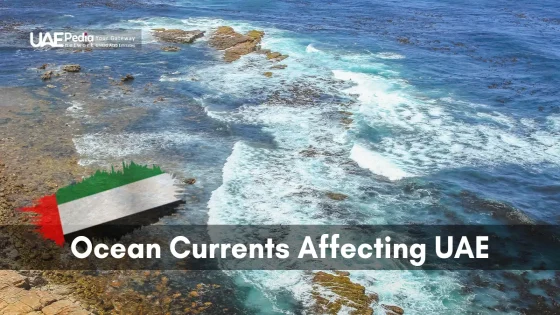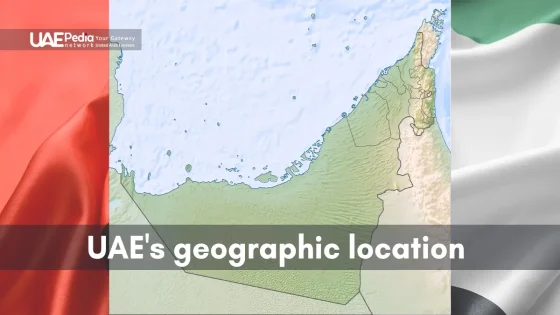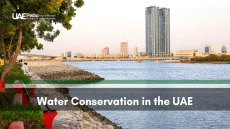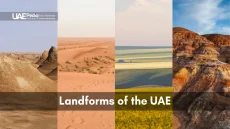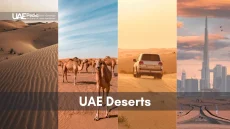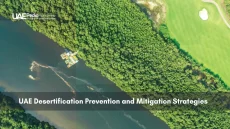Ocean currents shape the UAE’s climate and ecosystems. They impact the nation’s weather and biodiversity. The UAE’s marine life, including fish and sea turtles, is influenced by these currents.
UAE’s ocean flow dynamics: a critical factor in its environmental balance.
The UAE’s location, with coastlines on the Arabian Gulf and Gulf of Oman, is unique. These marine currents affect the UAE’s climate, changing temperatures and humidity. They also shape the country’s marine life and coastal ecosystems.
The UAE protects its nature with 43 nature reserves covering 14% of its land. It has also set up 10 Wetlands of International Importance, covering 39,166 hectares. These areas are home to a wide variety of marine life in the Gulf waters.
UAE’s Unique Geographical Position
The United Arab Emirates has a special geography. It makes the UAE a key player in the Gulf region. Its location is crucial for being a global trade center and diplomatic hub.
The Arabian Gulf and Gulf of Oman Coastlines
The UAE’s coastline is 770 kilometers long. It has 700 kilometers along the Arabian Gulf and 70 kilometers on the Gulf of Oman. This unique coastline gives the Emirates marine benefits and affects its climate.
UAE’s Marine Topography
The UAE’s sea area is varied. It has coral reefs, mangrove creeks, and different habitats. These areas support a lot of marine life and are important for the environment.
Coastal Features and Water Depths
The UAE’s coastline is very different. The Arabian Gulf side has shallow waters and flat land, perfect for ports. The Gulf of Oman coast is rocky with deeper waters, offering unique marine chances.
| Coastline | Length (km) | Characteristics |
|---|---|---|
| Arabian Gulf | 700 | Shallow waters, flat terrain |
| Gulf of Oman | 70 | Deep waters, rugged landscape |
This special geography helps the UAE have big ports like Jebel Ali, Khalifa, and Fujairah. It makes the UAE a key place for global trade. The country’s location makes it easy to move goods around the world through airports, seaports, and roads.
Ocean Currents Affecting UAE
The UAE sits between the Arabian Gulf and the Gulf of Oman. This spot creates a complex system of ocean currents. These currents are key to the country’s climate and marine life.
Strait of Hormuz Current Patterns
The Strait of Hormuz connects the Arabian Gulf to the Gulf of Oman. It has strong currents that affect marine life and water properties along the UAE coast.
Seasonal Current Variations
Major ocean currents near UAE change with the seasons. These changes impact water temperature, salinity, and nutrients. In summer, currents flow counterclockwise in the Arabian Gulf. Winter sees a reversal.
| Season | Current Direction | Impact on UAE Waters |
|---|---|---|
| Summer | Counterclockwise | Warmer waters, increased salinity |
| Winter | Clockwise | Cooler waters, decreased salinity |
Impact of Indian Ocean Currents
Indian Ocean currents affect the UAE’s eastern coast. They shape weather and marine life in the Gulf of Oman. These currents bring nutrient-rich waters, supporting diverse marine life along the UAE’s eastern shoreline.
Understanding these ocean currents is vital for marine conservation and coastal planning in the UAE. The mix of currents creates unique conditions that support the country’s rich marine biodiversity.
Marine Ecosystems and Current Interactions
The UAE’s marine ecosystems and currents are a complex network. They shape the coastal environment and support diverse marine life. The movement of UAE coastal waters influences coral reefs and mangrove forests, creating unique habitats for many species.
Coral Reef Systems and Water Movement
Coral reefs in the UAE depend on ocean currents for nutrients. The marine circulation helps spread coral larvae, promoting reef growth. These ecosystems need steady water movement to remove waste and bring in fresh water.
Mangrove Habitats and Tidal Influences
Mangrove forests along the UAE coast are nurseries for marine species. Tidal currents mix saltwater and freshwater, creating a unique environment. This supports a rich biodiversity and protects shorelines from erosion.
Marine Biodiversity Zones
The UAE’s waters have several important marine biodiversity zones. These areas show the incredible variety of life supported by ocean currents. Let’s look at some key biodiversity hotspots:
| Biodiversity Zone | Location | Notable Features |
|---|---|---|
| Marawah Marine Biosphere Reserve | Abu Dhabi | Dugongs, sea turtles, coral reefs |
| Sir Bu Na’air Island | Sharjah | Hawksbill turtles nesting site, seabirds |
| Ras Al Khor Wildlife Sanctuary | Dubai | Flamingos, mangroves, migratory birds |
These biodiversity zones are crucial for conservation in the UAE. They show the importance of protecting marine ecosystems and understanding ocean currents. As the UAE aims to reduce emissions by 47% by 2035, these efforts will also help preserve these habitats for future generations.
Climate Patterns Shaped by Ocean Currents
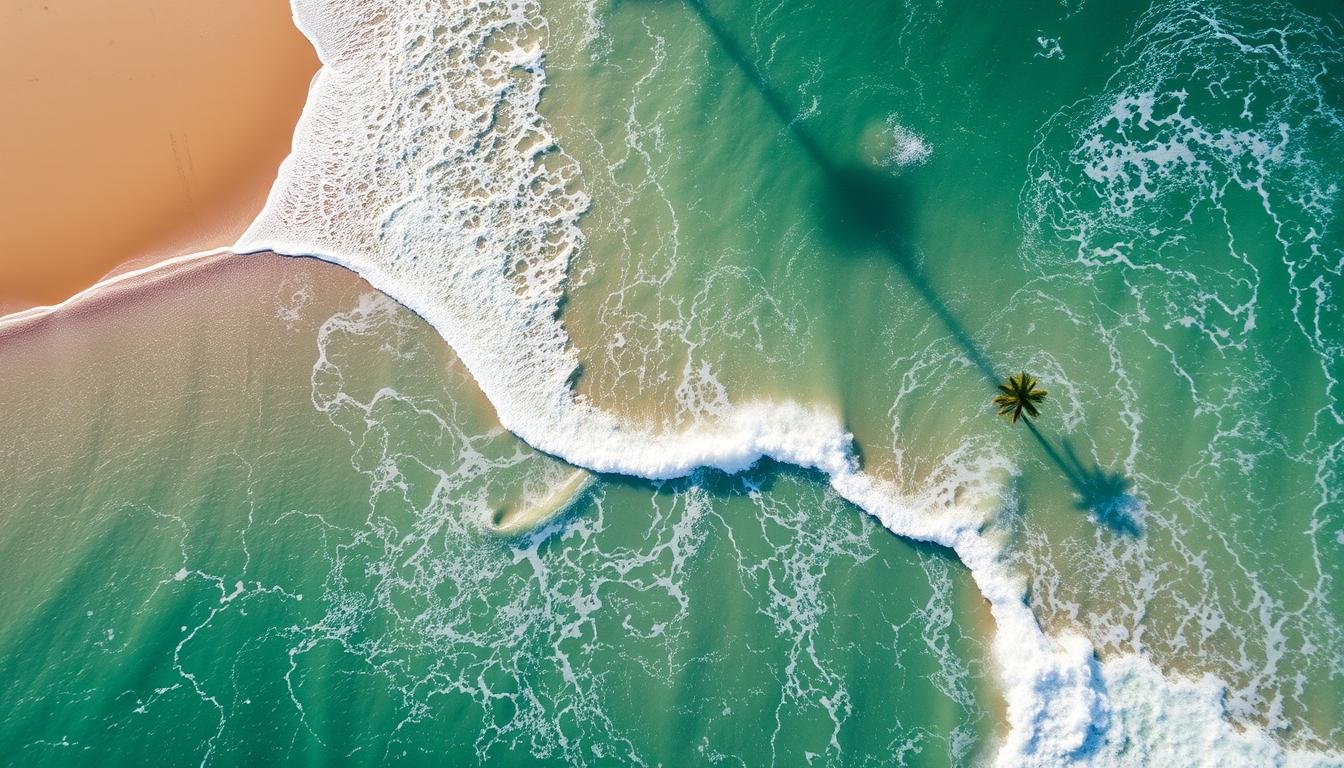
Ocean currents have a big impact on the UAE’s climate. They help shape the weather in the area. The mix of warm Gulf waters and cooler Indian Ocean currents changes the temperature and humidity by the coast.
These currents do more than just change the temperature. They also affect how much rain falls and how hard it rains. Studies show that heavy rain in El Niño years in the UAE is 10-40% heavier because of climate change. For example, Dubai got over 14cm of rain in 24 hours, which is a lot for there.
It’s important to understand the UAE’s ocean currents to predict the weather. The UAE has set up advanced weather stations and works with global climate groups. This helps them plan for water needs, which is a big issue in GCC countries.
The UAE Cloud Seeding Program is part of these efforts. But a study found that cloud seeding didn’t really help with the heavy rain. This shows how complex the weather is and why we need to keep studying and adapting.
As the world gets warmer, the air can hold more moisture. This means the UAE might see even more intense rain and flooding in the future.
Impact on Coastal Development and Infrastructure
The UAE’s coast faces big challenges from ocean currents and rising sea levels. With 30 million people in coastal cities, this number will double soon. The UAE’s maritime infrastructure must quickly adapt.
The country’s fast growth and land projects have changed coastlines. This brings new chances and risks.
Coastal Erosion Management
Now, UAE port plans focus on stopping erosion. Sea levels could rise up to 1.10m by 2100. Low-lying areas are at high risk.
The Urban Planning Council (UPC) in Abu Dhabi was set up in 2007. It oversees coastal protection to fight erosion and flooding.
Maritime Construction Considerations
UAE maritime projects must think about ocean currents. The Al-Qana waterfront in Abu Dhabi is 2.4 km long. It’s designed with water flow in mind.
Hydrodynamic modeling is key for these projects. It ensures water flows well, which is vital for their future.
Port and Harbor Development
UAE port development is growing fast to support the economy. The national aquarium in Al-Qana is 7,000sqm. It shows how construction can mix business and tourism.
These projects aim to build quality communities and grow industries. They balance development with caring for the environment.
Abu Dhabi’s population is growing, with 81% expats. Waterfront projects aim to make living there better. They offer diverse housing to create sustainable, thriving communities.
Environmental Conservation and Current Dynamics
The UAE is dedicated to saving marine ecosystems. It studies ocean currents to protect them. This helps in making plans for the environment and adapting to climate change.
Marine Protected Areas
The UAE has set up marine protected areas. These places are safe for marine life. They keep the balance of ecosystems, even with currents.
Ecosystem Preservation Strategies
The UAE works hard to protect marine habitats. Coral reefs and mangrove forests are key. They help protect the coast and keep biodiversity alive.
Projects restore habitats and manage resources well. This keeps the marine life safe.
Climate Change Adaptation Measures
The UAE is ready for climate change’s effects on the sea. It studies how climate change changes ocean currents. This helps protect marine life and coastal communities.
Public campaigns teach people to use the sea wisely. They encourage everyone to help protect the marine world.
A study showed Dubai Creek’s extension helped water flow. It cut down water time from 45 to 33 days. This shows how important planning is for marine conservation. The UAE keeps working on research and new ways to protect its coasts.
Conclusion
Ocean currents are key to the UAE’s climate and sea life. The UAE’s location by the Arabian Gulf and Gulf of Oman makes its sea life varied. These currents shape the climate and affect the coast, buildings, and nature protection.
Climate change is a big problem for ocean currents and UAE coasts. Rising temperatures and wind changes bring more extreme weather. The UAE’s recent floods caused big damage, with Dubai hit the hardest.
The UAE needs to grow its coast while keeping nature safe. It must prepare for disasters and protect its sea life. By understanding ocean currents, the UAE can face climate challenges and keep its sea life safe for the future.
